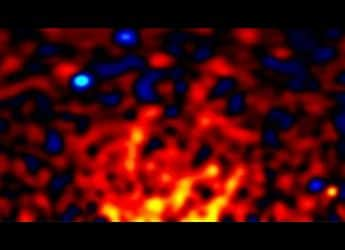- Home
- Science
- Science News
- Dark Matter May Have Been Seen for the First Time in NASA Gamma Ray Data
Dark Matter May Have Been Seen for the First Time in NASA Gamma-Ray Data
NASA’s Fermi telescope has detected a 20-GeV gamma-ray halo around the Milky Way’s center that may match dark-matter annihilation.

Photo Credit: NASA
Fermi gamma-ray data show a faint 20-GeV halo, hinting at dark-matter annihilation; more study needed
Direct observation of dark matter has long been elusive. Fritz Zwicky first proposed this invisible substance in the 1930s. It is thought to make up about 85% of all matter and is inferred from the motion of galaxies. It was only known indirectly through gravity for decades. The first concrete proof of dark matter may have come from gamma-ray data collected by NASA's Fermi telescope. This would be the first direct observation of dark matter, if verified.
Gamma-Ray Clues
According to the published study, a team of researchers led by Tomonori Totani of the University of Tokyo analysed Fermi's observations of the Milky Way's center, where dark matter should be densest. He found a faint halo of very high-energy (20-GeV) gamma rays extending around the galactic core.
The energy and shape of this emission match theoretical predictions for colliding WIMPs (weakly interacting massive particles) about 500 times a proton's mass. Totani says no known astrophysical source easily explains the signal. He calls it a strong indication of dark-matter annihilation and says it could be 'the first time humanity has seen dark matter'.
Skepticism and Next Steps
Experts urge caution. Totani notes that independent checks are needed to confirm the findings. The team proposes looking for the same 20-GeV gamma-ray signature in other dark-matter-rich regions, such as dwarf galaxies around the Milky Way. According to The Guardian, Prof Justin Read, an astrophysicist at the University of Surrey, reportedly points out that if dark matter were responsible, similar gamma rays should appear in those dwarf galaxies — but none have been seen yet. For now, this result is intriguing but far from definitive.
Get your daily dose of tech news, reviews, and insights, in under 80 characters on Gadgets 360 Turbo. Connect with fellow tech lovers on our Forum. Follow us on X, Facebook, WhatsApp, Threads and Google News for instant updates. Catch all the action on our YouTube channel.
Related Stories
- Samsung Galaxy Unpacked 2025
- ChatGPT
- Redmi Note 14 Pro+
- iPhone 16
- Apple Vision Pro
- Oneplus 12
- OnePlus Nord CE 3 Lite 5G
- iPhone 13
- Xiaomi 14 Pro
- Oppo Find N3
- Tecno Spark Go (2023)
- Realme V30
- Best Phones Under 25000
- Samsung Galaxy S24 Series
- Cryptocurrency
- iQoo 12
- Samsung Galaxy S24 Ultra
- Giottus
- Samsung Galaxy Z Flip 5
- Apple 'Scary Fast'
- Housefull 5
- GoPro Hero 12 Black Review
- Invincible Season 2
- JioGlass
- HD Ready TV
- Laptop Under 50000
- Smartwatch Under 10000
- Latest Mobile Phones
- Compare Phones
- Poco F8 Ultra
- Poco F8 Pro
- Huawei Mate 80 RS Master Edition
- Huawei Mate 80 Pro Max
- Huawei Mate 80 Pro
- Huawei Mate 80
- Huawei Mate X7
- Honor 500
- Asus ProArt P16
- MacBook Pro 14-inch (M5, 2025)
- Poco Pad M1
- Poco Pad X1
- Honor Watch X5
- Huawei Watch Ultimate 2
- Acerpure Nitro Z Series 100-inch QLED TV
- Samsung 43 Inch LED Ultra HD (4K) Smart TV (UA43UE81AFULXL)
- Asus ROG Ally
- Nintendo Switch Lite
- Haier 1.6 Ton 5 Star Inverter Split AC (HSU19G-MZAID5BN-INV)
- Haier 1.6 Ton 5 Star Inverter Split AC (HSU19G-MZAIM5BN-INV)

















